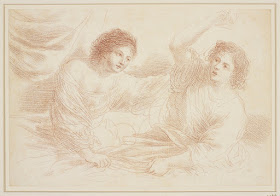 |
| Guercino (Giovanni Francesco Barbieri) Damon and Pythias 1632 oil on canvas Palazzo Rospigliosi, Rome |
 |
| Guercino (Giovanni Francesco Barbieri) Damon and Pythias (detail) 1632 oil on canvas Palazzo Rospigliosi, Rome |
The knight at left, witnessing the execution in the detail above, and departing from convention, breaks through the so-called fourth wall, gazing directly at the viewer and lifting a hand in a gesture that might be interpreted as a greeting.
 |
| Guercino (Giovanni Francesco Barbieri) Damon and Pythias (detail) 1632 oil on canvas Palazzo Rospigliosi, Rome |
 |
| Guercino (Giovanni Francesco Barbieri) Damon and Pythias (detail) 1632 oil on canvas Palazzo Rospigliosi, Rome |
 |
| Guercino (Giovanni Francesco Barbieri) Damon and Pythias 1632 drawing (compositional study) Art Institute of Chicago |
 |
| Guercino (Giovanni Francesco Barbieri) Damon and Pythias 1632 drawing (compositional study) British Museum |
 |
| Guercino (Giovanni Francesco Barbieri) Damon and Pythias 1632 drawing (figure study) private collection |
 |
| Guercino (Giovanni Francesco Barbieri) Damon and Pythias 1632 drawing (figure study) Victoria & Albert Museum, London |
"[Carlo Cesare] Malvasia listed Damon and Pythias among the commissions of 1632, painted for Cardinal Giovanni Battista Maria Pallotta, then Papal Legate to Ferrara. The account book records the Cardinal's payment of 300 scudi on 26 May 1632. . . . According to Malvasia's supplementary note about the commission, when Pallotta drew up his will in Rome he instructed his executors to give His Holiness the choice of one of his pictures. It had generally been assumed that the beneficiary was Pope Alexander VII (Chigi) (reg. 1655-67), but, as [Piero] Boccardo pointed out, Alexander VII died eight months before Pallotta. The picture was thus offered to Alexander's successor, the Rospigliosi pope Clement IX (reg. 1667-9) – hence its presence to this day in the Palazzo Rospigliosi, Rome."
 |
| Guercino (Giovanni Francesco Barbieri) Stigmatization of St Francis 1632 oil on canvas Chiesa delle Sacre Stimmate, Ferrara |
 |
| Guercino (Giovanni Francesco Barbieri) Stigmatization of St Francis 1632 drawing (figure studies) Ashmolean Museum, Oxford |
"Malvasia recorded the Stigmatization of St Francis, still in situ in the church of the Sacre Stimmate, Ferrara, among Guercino's commissions for 1632. . . . Despite an agreed price of 100 ducatoni, cited in the account book entry for the deposit, Guercino received a total of only 62 ducats (80 scudi). The drop in the price is puzzling. The patrons may have made up the difference by some other means, but Guercino was famed for his rigidity on the issue and had not long before rejected an offer from the canons of Reggio Emilia Cathedral for suffrage for him and the deceased of his family as recompense for his work. . . . In the following 20 years, Guercino painted a further six altarpieces of the subject, subtly varying the compositions of each one. If the seven works are hard to distinguish from one another, even more so are the various preparatory studies made for them."
 |
| Guercino (Giovanni Francesco Barbieri) Virgin and Child with St Lucy, St Francis, St John the Evangelist and St John the Baptist (lost painting) 1632 drawing (figure studies) Ashmolean Museum, Oxford |
 |
| anonymous copyist after Guercino Neptune with his Trident (lost painting) after 1632 oil on canvas private collection |
 |
| anonymous copyist after Guercino Neptune with his Trident (detail) (lost painting) after 1632 oil on canvas private collection |
 |
| Guercino (Giovanni Francesco Barbieri) Neptune with his Trident 1632 drawing (compositional study) Scottish National Gallery, Edinburgh |
 |
| Guercino (Giovanni Francesco Barbieri) St Thomas the Apostle 1632 oil on canvas (unfinished) private collection |
"Due to the financial difficulties of a certain 'Signore Colonello di Bologna,' substantial passages of Guercino's warm brown grounds have been preserved for posterity in the unfinished St Thomas the Apostle (1632) [which remained in the artist's workshop as a model]. At top left, a lightly brushed patch of white indicates the light source. The grey-black halo around the saint's head is darker than the warm priming, and less reflective, to ease the modelling of the delicate transitions in colour and tone in the saint's head. Guercino must already have intended dramatic storm clouds as a backdrop, appreciably darker than the light-brown ground, but the artificial halo was a temporary step, meant to be overpainted with sky."
– quoted texts from The Paintings of Guercino: a revised and expanded catalogue raisonné by Nicholas Turner (Rome: Ugo Bozzi Editore, 2017)










































